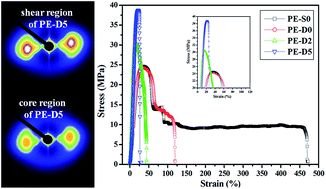Suppressing the skin–core structure in injection-molded HDPE parts via the combination of pre-shear and UHMWPE†
Abstract
In this study, pre-shear and ultrahigh molecular weight polyethylene (UHMWPE) were introduced to suppress the skin–core structure of injection-molded high density polyethylene (HDPE) parts. The structural characteristics of the injection-molded parts were systematically elucidated through scanning electron microscopy (SEM), two-dimensional wide-angle X-ray diffraction (2D-WAXD) and two-dimensional small-angle X-ray scattering (2D-SAXS). The results showed that oriented lamellae were formed in the core region upon pre-shear, and the orientation level of oriented lamellae in core region was further enhanced with increasing concentration of UHMWPE. More interestingly, a much narrowed orientation gap between the shear region and core region was obtained if the UHMWPE concentration was increased to 5 wt%. Moreover, crystallinity, long period, and lamellar thickness also increased with increasing UHMWPE concentration upon pre-shear. Naturally, the tensile strength of the blend parts was promoted due to the narrowed orientation gap between the shear region and core region along with an enhanced orientation level and increased crystallinity, long period, and lamellar thickness.


 Please wait while we load your content...
Please wait while we load your content...